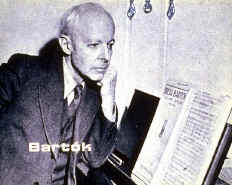|
Makers
Violin History & Timeline
PERFORMERS
Violin
Viola
Cello
Bass
Gamba, etc.
The Roots of Famous Violinists
TEACHERS
Violin
Viola
Cello
Bass
DEALERS
Listings
Specialist
Event
LUTHERIE
Bibliography
Listings
Gallery
COLLECTING
Identification
Buying
Selling
THE INSTRUMENTS
Violin
Viola
Cello
Bass
Viol
Bows
Tales
LINKS
Interesting Sites
GALLERY
Antique Instruments
Historical Photos
|
|
 Bela
Bartok’s indefatigable strength and spirit are apparent in his
distinctive music. Born in Transylvania, Bartok was an ill child who was
constantly plagued with bronchial problems. Unable to spend time playing
with other children, he became introverted and looked to music for
companionship. His mother was his first piano instructor, and she
tenderly nurtured Bartok’s obvious proclivity toward music. At the
young age of nine Bartok wrote his first waltz, and a year later he gave
his first solo performance as a pianist. Bartok’s mother treasured her
son’s talent, and despite financial hardships caused by the death of
her husband, she moved the entire family to Pressberg where Bartok could
study the piano from Laszlo Erkel. Bela
Bartok’s indefatigable strength and spirit are apparent in his
distinctive music. Born in Transylvania, Bartok was an ill child who was
constantly plagued with bronchial problems. Unable to spend time playing
with other children, he became introverted and looked to music for
companionship. His mother was his first piano instructor, and she
tenderly nurtured Bartok’s obvious proclivity toward music. At the
young age of nine Bartok wrote his first waltz, and a year later he gave
his first solo performance as a pianist. Bartok’s mother treasured her
son’s talent, and despite financial hardships caused by the death of
her husband, she moved the entire family to Pressberg where Bartok could
study the piano from Laszlo Erkel.
In 1899 Bartok joined the Liszt Academy in Budapest
where he began his discovery of Strauss’s tone poems. Desiring to
capture the Hungarian spirit through music, Bartok was in search of a
nationalistic style. In 1904 he found the inspiration he had been
longing for. While traveling through a small Hungarian town, Bartok
heard a young maid sing an unusual melody as she worked. Intrigued by
her lyricism, Bartok asked where her music was from. After learning that
it was a local folksong, Bartok began the investigation
and study of Hungarian folk music. He journeyed through Hungary, writing
down and recording all that he heard. Very different from traditionally
accepted Hungarian music, the regional pieces that Bartok discovered
were irregular, passionate, and strong. Mesmerized by the unique sounds
and melodies of the Hungarian peasants, Bartok initiated a
revitalization of Hungarian music.
In 1909 Bartok found himself teaching and structuring
musical arrangements in order to support himself financially. He married
one of his adored students, Marta Ziegler, and the couple quickly had a
son. During this time, Bartok’s greatest joy was to write pieces that
explored the possibilities of Hungarian folk music. Unfortunately,
audiences were not ready for such music. Bartok’s pieces deviated from
the norms of traditional composition, and incorporated unusual
techniques and sounds.
During Bartok’s first trip to the United States he
presented his most significant pieces. Sadly, audiences were not
impressed by Bartok’s works. Nonetheless, Bartok persevered and
continued incorporating Hungarian folk songs into his music. Thirteen
years later, he returned to the United States, setting up a home in New
York. By this time he had produced many noteworthy pieces such as his
Fifth and Sixth quartets, and had undergone a divorce and remarried
Ditta Pasztory. Attempting to distance himself from the war in Europe,
Bartok seized a research grant in folk music at Columbia University. For
a few years the grant’s meager allowance allowed Bartok to maintain a
reasonable standard of living. However, once the grant came to a close,
he found himself on the verge of poverty. His performances were not met
with enthusiasm, and he began to suffer from leukemia.
Nevertheless, this frail man had a formidable spirit
that gave him the strength to compose until the very end of his life.
Although he was in constant physical pain, his interest in music and
intellectual pursuits could not be crushed. The American Society of
Composers, Authors, and Publishers took on his medical bills, allowing
Bartok to receive the hospitalization and medication that he required.
While he was in hospital, Koussevitzky, Menuhin, and Primrose all
commissioned the writing of separate pieces. The production of these
works occupied the rest of Bartok’s life. He wrote constantly,
relentlessly attempting to complete all three commissions before he
passed away. In order to save time Bartok developed a shorthand method
of writing out measures and chords. His son would often sit by his
bedside, transcribing the shorthand or adding markings to the music.
Bartok passed away when he had completed all but the last few bars of
his final piano concerto.
This amazing individual did not live to see his work
embraced by audiences. Demanding and intense, Bartok’s pieces evoke
the humanity of their listeners. Today they are performed throughout the
world, memorializing the power and vision of a remarkable man.
Notes by Shanaira Udwadia (July-2001) |